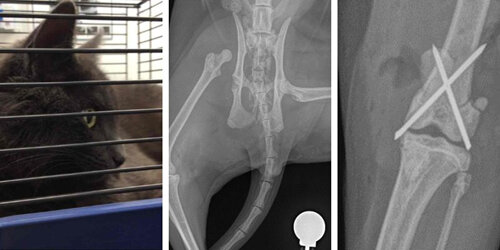Franklin Vets
Franklin Vets - excellence in veterinary care for dairy, farming, lifestyle, equine and household pets. BESTPRACTICE ACCREDITED NZ.
Your account is powered by Storbie. To edit your profile visit my.storbie.com
Your account is powered by Storbie. To edit your profile visit my.storbie.com

George was stabilised and had a battery of blood tests and x-rays to determine what the damage was. He had a severely dislocated hip in one leg, and a fractured femur in the other leg.
Both hindlegs had what is called plantigrade stance, which is where they walk with the whole of their foot on the ground, rather like a human does. This can be caused by rupture of the Achilles tendon, or by nerve damage to the nerves controlling the muscles of the leg, especially the sciatic nerve.
George went to surgery with a somewhat uncertain predicted outcome, as nerve injury is one of the most frustrating things we get to see. We have little or no control over whether that nerve is going to return to normal function, and it may take a very long time, weeks to months.
George had such a severely damaged hip joint that the ball of the femur had to be removed.
The femoral fracture was a challenge as the fragments were so far apart and had been trying to heal in their new positions, but we got them together and placed a couple of pins.
After surgery, George was not able to use the hindlegs much for some time. The right leg, which had lost the hip, was much worse, and had no pain sensation or motion for many weeks.
The left leg improved well, but the right continued to cause problems, including developing sores from being rubbed on the ground, which then became infected. George also developed significant pain in the foot, which could have been from the infection or from irritated nerve endings.
Amputation of the limb was considered several times.
Eventually, five months after the original injury, function returned to Geroge’s right leg, and he managed to start walking around normally again.
Nerve healing is notoriously slow. It can take months or even years for healing to progress. During that time, there is a risk of further injury if they cannot feel the leg, or if they are getting sharp nerve pain from the damaged endings. But sometimes, patience is rewarded, and in this case, George was lucky to have extremely committed and caring owners, who refused to contemplate amputation until every possible chance had been given. And that persistence was to the enormous benefit of George and his future life.
Paul Eason BVM&S MANZCVS (Surgery; Emergency and Critical Care Medicine)
Franklin Vets - excellence in veterinary care for dairy, farming, lifestyle, equine and household pets. BESTPRACTICE ACCREDITED NZ.



